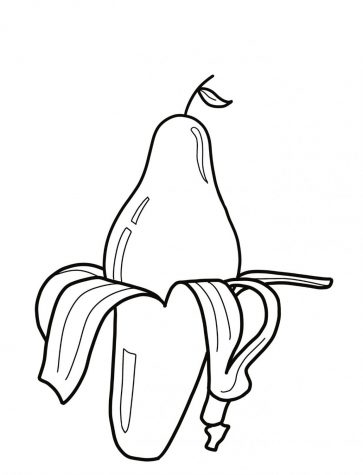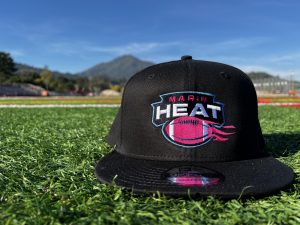Brandy Melville: one size fits (sm)all
April 3, 2021
When I first began shopping at Brandy Melville in middle school, I was entranced. The piles of semi-neatly folded tank tops and well-dressed, intimidating older girls at the cash register signified an era of freedom I yearned for. But beneath the simple clothing designs and affordable jewelry lies a “one size fits all” policy that pushes a cookie cutter body type onto middle and high schoolers.
Take a look at any Brandy Melville tag from an older collection, and you’ll be greeted with the phrase “one size fits all.” Although they eventually removed the tags, the one size fits all sentiment remains prevalent in Brandy Melville stores. This would be a semi-harmless business model if the clothing actually fit a multitude of sizes, but it doesn’t.
For example, a popular pair of jeans on the website, the Feanne Light Wash Jeans, only comes in a size S. These jeans have a 26 inch (66 centimeter) waist, a full 6.6 inches smaller than the national average waist size for teenage girls at 32.6 inches. Furthermore, the only clothes that come in more than one size are items like sweatshirts and t-shirts, which can be bought in an “oversized fit” or “regular fit.” Sure, it’s a half-hearted attempt at offering more than one size; however, calling any clothing item “oversized” if it comes in a size larger than small pours salt in the wound of all girls who don’t fit into the “regular fit” clothes. If Brandy Melville wanted to cater to a more diverse customer base, they’d actually carry multiple sizes for different bodies, not just two sizes both made for smaller people.
With this in mind, I have to wonder what body types Brandy Melville executives have in mind when they say their sizes fit everyone.
 Except Brandy Melville no longer proclaims to be a “one size fits all” company, which almost makes the sting of its exclusivity worse. The brand doesn’t even try to hide behind well-meaning attempts at body diversity. Rather, their decision to carry clothes in only the XS/S or S/M size was an intentional endeavor. Brandy Melville executives know their small clothes fit only a specific body type and they feed off of this, putting only tall, skinny and flat models on their website and in their stores as cashiers.
Except Brandy Melville no longer proclaims to be a “one size fits all” company, which almost makes the sting of its exclusivity worse. The brand doesn’t even try to hide behind well-meaning attempts at body diversity. Rather, their decision to carry clothes in only the XS/S or S/M size was an intentional endeavor. Brandy Melville executives know their small clothes fit only a specific body type and they feed off of this, putting only tall, skinny and flat models on their website and in their stores as cashiers.
On May 24, 2020, TikTok user calliejeanxo posted a TikTok (the first of many she’d make on this issue) outlining her experience working at Brandy Melville. In the video, Callie said, “A girl that was bigger than the rest of us wasn’t allowed to come back from behind the cashier so no one could see her body.” Callie hasn’t worked at Brandy Melville since 2013, but she acknowledged in part 18 of the series that the store environment is relatively unchanged. Though only one girl’s experience, it seems too similar to Brandy Melville’s sizing policy and social media presence to be just an isolated incident.
One could argue that Brandy Melville is merely being irresponsible rather than calculating. After all, it wouldn’t be fair to blame one company for a culture of fat shaming that has been around since the Renaissance. And, as an independent company selling clothes in a free country, Brandy Melville is allowed to advertise their clothes however they want. But in an era where 13.2 percent of girls have struggled with some form of eating disorder by the age 20 (according to the National Eating Disorders Association) and 75 percent of Redwood students have felt negatively about their bodies (according to a March Bark survey), this level of carelessness is unethical. With a customer base of primarily tweens and young adults, the demographic most likely to develop an eating disorder according to the British Columbia Children’s Hospital, Brandy Melville needs to stop enforcing body standards and instead become part of the solution.
Other companies have already hopped on this body positivity bandwagon; teen clothing brands such as ASOS and Aerie offer a diverse range of sizes and make a point not to retouch photos. However, both companies actually made more money than Brandy Melville in 2018 (the most recent year data is available), with Aerie’s revenue reaching $650 million and ASOS’s hitting $2417.3 million, compared to Brandy Melville’s $300 million. If Aerie and ASOS can make a higher profit while maintaining a body positive marketing plan, Brandy Melville could easily do the same.
Brandy Melville still provides many middle schoolers with their first taste of freedom; their low prices allow clothes to be bought with pocket money or wages from first babysitting jobs, and their one size policy arguably makes shopping simpler. But, this freedom is undermined by the limited nature of their advertising and clothing sizes. With more clothing brands celebrating size inclusivity, it’s time to outgrow this “one size fits all” culture.







